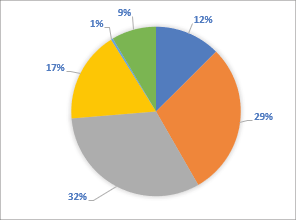222 | nº 31, pp. 207-238 | doxa.comunicación
July-December of 2020
Study on the cinematographic image composition: frame, light, and colour as expressive elements...
ISSN: 1696-019X / e-ISSN: 2386-3978
The full shot appears 34 times, once more than the medium shot. The least used is the cover shot, only on 2 occasions. The full shot and the connection shot are used in three images. The reaction shot doesn’t exist in this work. The most used close-ups are the medium or bust shot, used 79 times, and the long shot appears 72 times. We find that the medium or torso shot or the extreme close-up is used 43 and 31 times, respectively, and the foreshortened in 21 compositions. The least used is the close-up, which is only used once.
Graph 4: Percentages on the use of different types of close-ups
Source: Created by the authors
3.2.2. Lighting
The Lighting in the Man Who Wasn’t There has a two-fold function: both expressive and dramatic. By modifying this film to black and white, the lighting is different from the rest of the films selected for this study, mainly because of how this film is made. The works lacking colour are primarily shot on sets that are partly illuminated to enhance objects or characters and attempt to manage the light on the scene better (Tolan, 1941).
The images that make up the film are not grainy. This technique gives higher quality to the work and allows us to obtain a unique texture. A smaller depth of field is created through an open diaphragm, and consequently, the backgrounds appear out of focus. This is much more evident when the light is on the characters to make them stand out (figure 9). This aspect is more noticeable in those scenes that the lighting creates a backlighting effect (recurrent throughout the film); placing the subjects in front of the light source and the camera in a lateral position or behind them, using direct, harsh and intense lighting, creating an effect that adds drama to the action. For instance, the use of background lighting with this
